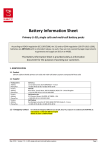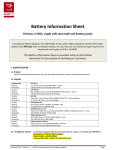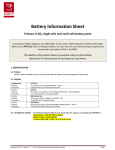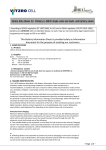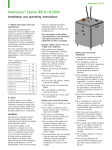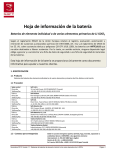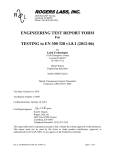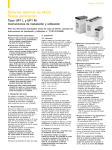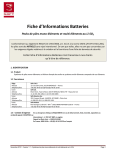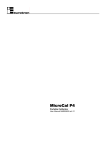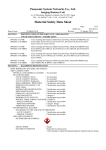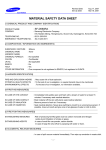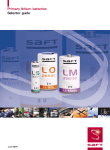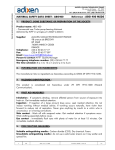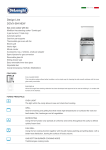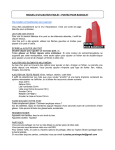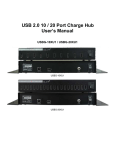Download BATTERY INFORMATION SHEET
Transcript
Battery Information Sheet Dry silver/zinc oxide cells, battery kits and battery systems According to REACH regulation (EC 1907/2006, Art 31) and to OSHA regulation (29 CFR 1910.1200), batteries are ARTICLES with no intended release. As such, they are not covered by legal requirements to generate and supply an SDS or an MSDS. This Battery Information Sheet is provided solely as an information document for the purpose of assisting our customers. 1. IDENTIFICATION 1.1 Product Dry secondary silver/zinc oxide cells, battery kits systems and battery systems composed of these cells. N. B.: This document refers to dry silver/zinc oxide cells as Ag/ZnO: For electrolyte risks, please refer to the electrolyte security data sheet. For wet cells, please refer to specific recommendations from the supplier. 1.2 Supplier Headquarters Address Phone/Fax Factory Address Phone/Fax Saft S.A.S. 12 rue Sadi Carnot, 93170 BAGNOLET – France Phone/Fax: +33 (0)1 49 93 19 18 /+33 (0)1 49 93 19 50 Saft Poitiers Rue Geoges Leclanché – BP n°1039, 86060 POITIERS Cedex 9 - France +33 (0)5 49 55 48 48 /+33 (0)5 49 55 48 50 1.3 Emergency contact Chemtrec US Service within the USA: +1 800 424 93 00/outside : +1-703 527 3887 2. HAZARD IDENTIFICATION 2.1 At cell level Not chemically dangerous with normal use in accordance with Saft recommendations as stated in the user manual or other similar documentation. In particular, the battery should not be opened or burned. Exposure to the ingredients contained within or their combustion products could be harmful. EYE CONTACT: Dust can cause inflammation of eyelids. SKIN CONTACT: Dust may cause irritation to skin. Contains mercury oxide that can be lethal in case of skin absorption. INHALATION: Contents of an opened cell can cause respiratory tract and mucus membrane irritation (nose and throat). Contains mercury oxide that can be lethal by inhalation. INGESTION: Contains mercury oxide that can be lethal in case of ingestion. ENVIRONMENTAL IMPACT: Very toxic to aquatic life January 2014 – Version 1.2 – Dry silver/zinc oxide cells, battery kits systems and battery systems Page 1 TEMPERATURE: Do not place the batteries on or near fires or other high-temperature locations (> 70°C). 2.2 At module and battery system level For batteries issues see specific documentation provided by SAFT. 3. COMPOSITION, INFORMATION OR INGREDIENTS 3.1 At cell level Component Silver Negative active material Comprising mercury oxide Metallic and inert material Non metallic material CAS Number 7440-22-4 N/A EINECS/ELINCS 231-131-3 N/A N/A N/A N/A N/A Content (wt. %)* 25-35 25-30 <0.5 15-20 15-30 * Quantities may vary a little with cell model 3.2 At module and battery system level Depending on the type of battery system. 4. HANDLING AND STORAGE IMPORTANT NOTICE: The battery should not be opened without Saft approval, destroyed or incinerated since the ingredients contained in the cells could be harmful under some circumstances if exposed. STORAGE : Store in a cool, dry and ventilated area. Elevated temperatures can result in shortened battery life. Keep batteries in original packaging until use and do not jumble them. HANDLING : Do not short (+) or (-) terminal with conductors/conductive materials. Do not open the battery system or modules. Do not submit to excessive mechanical stress. Do not expose the unit to water or condensation. Do not directly heat, solder or throw into fire. Such unsuitable use can cause toxic fumes and dust. 5. PHYSICAL AND CHEMICAL PROPERTIES The dry silver/zinc oxide cell or battery described by this Battery Information Sheet is a sealed unit when offered for sale. It is a manufactured “article” and does not expose the user to hazardous chemicals when used in accordance with manufacturer specifications. Boiling Point – Not applicable Vapor Pressure – Not applicable Specific Gravity – Not applicable Melting Point – Not applicable Vapor Density – Not applicable January 2014 – Version 1.2 – Dry silver/zinc oxide cells, battery kits systems and battery systems Page 2 6. STABILITY AND REACTIVITY – the battery system is stable when handled and stored according to section 4 MATERIALS TO AVOID: Materials contained in these cells can react with various types of chemicals (for example oxidizing agents, acids, bases, reducing agents…). As a consequence, active material contained in these cells will not be mixed or put in contact with any type of chemicals. CONDITIONS TO AVOID: Avoid exposing battery to fire or temperature >70°C. Do not disassemble, crush or short. Avoid mechanical or electrical abuse. HAZARDOUS DECOMPOSITION PRODUCTS: Thermal decomposition of the cell produces harmful and toxic fumes (metals/metal oxide) and dusts. 7. TOXICOLOGICAL INFORMATION Risk of irritation occurs only if the cell is mechanically, thermally or electrically abused to the point of compromising the enclosure. If this occurs, irritation to the skin, eyes and respiratory tract may occur. Contains mercury oxide that can be lethal in case of inhalation, ingestion or skin contact 8. ECOLOGICAL INFORMATION There is no ecological harm when cells are used correctly and recycled after use has ended. In case of mechanical abuse of the cell container, active material is very toxic to aquatic life (acute and chronic toxicity). Any contact with aquatic life must be avoided. 9. DISPOSAL CONSIDERATIONS Battery recycling is either mandatory (European Directive 2006/66/EC) or recommended. Batteries should be fully discharged prior to disposal and terminals protected. Dispose in accordance with local laws and regulations. Store material for disposal as indicated in Section 4. Do NOT dump into any sewers, on the ground or into any body of water. Disposal considerations: See the section on ”Sustainability & Environment” on http://www.saftbatteries.com 10. TRANSPORTATION INFORMATION Important: Dry silver-zinc cells are not classified under transportation regulation. All information in this paragraph concerns the alkaline electrolyte. For specific information concerning wet cells or batteries, see SAFT transportation documentation. 10.1 United Nations Class (Transportation information for alkaline electrolyte only) Class UN N°: Hazard Classification: Packaging: UN2797, battery fluid, alkali 8 Group II 10.2 International agreements (Transportation information for alkaline electrolyte only) By Air International: By Sea International: European road transportation: European rail transportation: IATA IMDG ADR (road) RID January 2014 – Version 1.2 – Dry silver/zinc oxide cells, battery kits systems and battery systems Page 3 11. REGULATORY INFORMATION Marking Consideration European Union: According to directive 2006/66/EC, the batteries have to be marked with the crossed wheel bin symbol. 12. FIRST AID MEASURES (not anticipated under normal use) EYE CONTACT: Immediately flush with copious amount of water for more than 15 minutes. Seek immediate medical attention. SKIN CONTACT: Remove contaminated clothing and flush affected areas with plenty of water for at least 15 minutes. Wash skin with soap and water. Seek immediate medical attention. INHALATION: Remove to fresh air and seek immediate medical attention. INGESTION: Clear mouth with water. Do not induce vomiting. Seek immediate medical attention. 13. FIRE FIGHTING MEASURES (not anticipated under normal use) ESTINGUISHING MEDIA: Use appropriate extinguishing media according to the type of fire. In case of water use, contaminated water had to be contained and avoid sewage, surface water and underground water contamination. SPECIAL FIRE FIGHTING PROCEDURES: Fire fighters should wear self-contained breathing apparatus. Use approved / certified vapour respirator to avoid breathing toxic fumes. Wear protective clothing and equipment to prevent potential body contact with dust and fumes. It is permissible to use any class of extinguishing medium, specified above, on these batteries or their packing material. Cool exterior of batteries if exposed to fire to prevent rupture. PARTICULAR HAZARDS RESULTING FROM EXPOSURE TO THE SUBSTANCE/PREPARATION, TO COMBUSTION AND GAS PRODUCTS: Cells material combustion will produce fumes and dust containing toxic metal or metal oxide substances. 14. EXPOSURE CONTROLS AND PERSONAL PROTECTION* (not necessary under normal use) Hand protection In case of incident, fumes or dust formation, use gas mask which covers the whole face and equipped with N100 or P3 type filters or escape mask type Self-Contained Breathing Apparatus. Fire fighters should wear self-contained breathing apparatus. Use polypropylene, polyethylene, rubber or Viton gloves when handling ruptured cells. Take off gloves without being in contact with the polluted side. Dispose all contaminated protections according to applicable regulation. Wash hands after any handling. Eye protection In case of incident or after an abusive use, in case of a cell opening, wear safety glasses with protected side shields or a mask covering the whole face when handling ruptured cells. Respiratory protection Other In the event of leakage or ruptured cells, wear a rubber apron and protective clothes. *AFNOR pictograms 15. ACCIDENTAL RELEASE MEASURES (not anticipated under normal use) INDIVIDUAL PRECAUTIONS: Evacuate the employees from the contaminated area until fumes or dust dispersal. Do not inhale fumes or dust without adequate respiratory protection. In case of skin or eye contact, inhalation or ingestion, follow the measured described in section 12. January 2014 – Version 1.2 – Dry silver/zinc oxide cells, battery kits systems and battery systems Page 4 ENVIRONMENTAL PRECAUTION: Avoid sewage, surface water and underground water contamination. Avoid ground and atmosphere contamination. In case of water contamination, alert competent authorities. WAYS OF CLEANING: Collect all material dispersed using appropriate personal protection, store in appropriate waste packaging and dispose of as special waste in accordance with local regulations. 16. OTHER INFORMATION This information has been compiled from sources considered to be dependable and is, to the best of our knowledge and belief, accurate and reliable as of the date compiled. However, neither exhaustively nor perfect reliability can be granted. Information does not imply implicit or specific warranty of it. This information relates to the specific products designated and may not be valid for such products used in combination with any other materials or in any process. It is the user’s responsibility to satisfy himself as to the suitability and completeness of this information for his particular use. Saft does not accept liability for any loss or damage that may occur, whether direct, indirect, incidental or consequential, from the use of this battery information sheet provided as a service to our customers. Saft does not offer warranty against patent infringement. 12, rue Sadi Carnot 93170 Bagnolet – France Tel.: +33 (0)1 49 93 19 18 Fax: +33 (0)1 49 93 19 69 www.saftbatteries.com Doc N˚ BIS 02-10-12 Edition: January 2014 Version 1.2 Data in this document is subject to change without notice and becomes contractual only after written confirmation. January 2014 – Version 1.2 – Dry silver/zinc oxide cells, battery kits systems and battery systems Page 5





